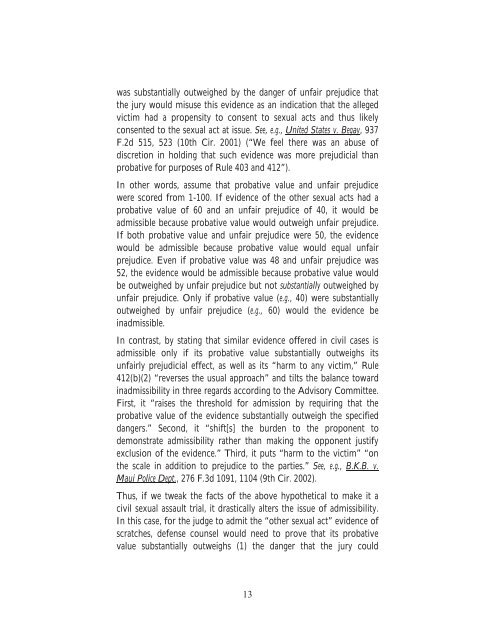Evidence - Rape Shield Rule, 2014a
Evidence - Rape Shield Rule, 2014a
Evidence - Rape Shield Rule, 2014a
You also want an ePaper? Increase the reach of your titles
YUMPU automatically turns print PDFs into web optimized ePapers that Google loves.
was substantially outweighed by the danger of unfair prejudice that<br />
the jury would misuse this evidence as an indication that the alleged<br />
victim had a propensity to consent to sexual acts and thus likely<br />
consented to the sexual act at issue. See, e.g., United States v. Begay, 937<br />
F.2d 515, 523 (10th Cir. 2001) (“We feel there was an abuse of<br />
discretion in holding that such evidence was more prejudicial than<br />
probative for purposes of <strong>Rule</strong> 403 and 412”).<br />
In other words, assume that probative value and unfair prejudice<br />
were scored from 1-100. If evidence of the other sexual acts had a<br />
probative value of 60 and an unfair prejudice of 40, it would be<br />
admissible because probative value would outweigh unfair prejudice.<br />
If both probative value and unfair prejudice were 50, the evidence<br />
would be admissible because probative value would equal unfair<br />
prejudice. Even if probative value was 48 and unfair prejudice was<br />
52, the evidence would be admissible because probative value would<br />
be outweighed by unfair prejudice but not substantially outweighed by<br />
unfair prejudice. Only if probative value (e.g., 40) were substantially<br />
outweighed by unfair prejudice (e.g., 60) would the evidence be<br />
inadmissible.<br />
In contrast, by stating that similar evidence offered in civil cases is<br />
admissible only if its probative value substantially outweighs its<br />
unfairly prejudicial effect, as well as its “harm to any victim,” <strong>Rule</strong><br />
412(b)(2) “reverses the usual approach” and tilts the balance toward<br />
inadmissibility in three regards according to the Advisory Committee.<br />
First, it “raises the threshold for admission by requiring that the<br />
probative value of the evidence substantially outweigh the specified<br />
dangers.” Second, it “shift[s] the burden to the proponent to<br />
demonstrate admissibility rather than making the opponent justify<br />
exclusion of the evidence.” Third, it puts “harm to the victim” “on<br />
the scale in addition to prejudice to the parties.” See, e.g., B.K.B. v.<br />
Maui Police Dept., 276 F.3d 1091, 1104 (9th Cir. 2002).<br />
Thus, if we tweak the facts of the above hypothetical to make it a<br />
civil sexual assault trial, it drastically alters the issue of admissibility.<br />
In this case, for the judge to admit the “other sexual act” evidence of<br />
scratches, defense counsel would need to prove that its probative<br />
value substantially outweighs (1) the danger that the jury could<br />
13


















